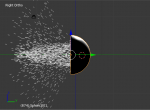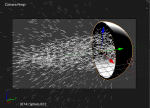Started working on an animation that will be the basis for my tutorials… When lighting, I find it most important to know what effect a light is going to have before placing it. In order to do that, one needs to know how light behaves… Not necessarily at the subatomic level specifically, but near enough that you understand the parts of light and how the photons move to be able to paint with them on set.
Anyway, to illustrate how light is generated, I created a sphere that throws particles at a regular rate… then show a surface to allow them to paint on and show the effect on a surface. also adding a reflector to show how they shape light and effect the penumbral width in relation to the core of the light where it reacts with a surface.

Anyway, to illustrate how light is generated, I created a sphere that throws particles at a regular rate… then show a surface to allow them to paint on and show the effect on a surface. also adding a reflector to show how they shape light and effect the penumbral width in relation to the core of the light where it reacts with a surface.





 Wes Anderson really is the master at creating memorable color schemes!
Wes Anderson really is the master at creating memorable color schemes! They make the Cinematographer look good.
They make the Cinematographer look good.